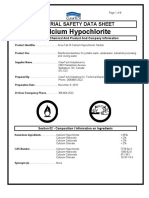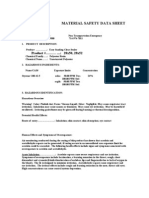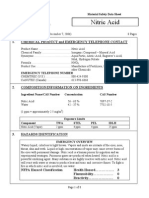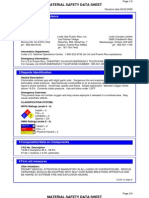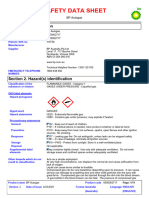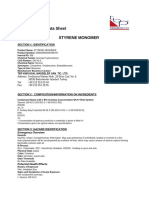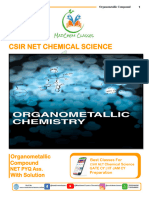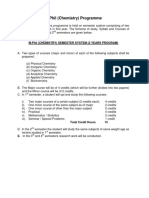PBP MSDS (2017 Renewal)
PBP MSDS (2017 Renewal)
Uploaded by
Nam VoCopyright:
Available Formats
PBP MSDS (2017 Renewal)
PBP MSDS (2017 Renewal)
Uploaded by
Nam VoOriginal Title
Copyright
Available Formats
Share this document
Did you find this document useful?
Is this content inappropriate?
Copyright:
Available Formats
PBP MSDS (2017 Renewal)
PBP MSDS (2017 Renewal)
Uploaded by
Nam VoCopyright:
Available Formats
[ PERBUTYL P ] page 1 of 3
S A F E T Y D A T A S H E E T
SDS No.F02111 Effective Date : 14, Oct. 1995 / The 8th Amended Date : 6, Jul. 2017
1. CHEMICAL PRODUCT AND COMPANY IDENTIFICATION
PRODUCT NAME : PERBUTYL P
MANUFACTURER : NOF CORPORATION
Yebisu Garden Place Tower
20-3, Ebisu 4-Chome, Shibuya-ku, Tokyo 150-6019 JAPAN
FACSIMILE (G3) : +81 (0)3-5424-6814
INFORMATIONAL TELEPHONE : +81 (0)3-5424-6838
2. COMPOSITION/INFORMATION ON INGREDIENTS
CHEMICAL COMPONENTS
Component: CAS Registry No. Exposure Guideline % by wt.
Di-(tert-butylperoxyisopropyl)benzene(s) 25155-25-3 No information ≧98
3. HAZARDS IDENTIFICATION
EMERGENCY OVERVIEW :
White powder with particular odor.
Can burn vigorously in fire.
Contact with phosphine, strong acids, reducing agent or heating may cause fire or hazardous decomposition with
producing flammable vapors, gases and fumes.
POTENTIAL HEALTH EFFECTS :
Irritating to skin and eyes.
May cause irritating to mucosa
4. FIRST AID MEASURES
ROUTE OF EXPOSURE.......: Skin contact / absorption, eye contact, inhalation, swallow.
EYES....................... : Remove any contact lenses at once.
Flush eyes well with copious quantities of water or normal saline for at least 20-30 minutes.
Seek medical attention.
SKIN....................... : Flood all areas of body that have contacted the substance with water.
Don’t wait to remove contaminated clothing; do it under the water stream.
Use soap to help assure removal.
INGESTION............ : Contact a physician, hospital or poison center at once.
If conscious and not convulsing, give a glass of water or milk to dilute the substance.
Vomiting should not be induced without a physician’s advice.
If the victim is unconscious or convulsing, DO NOT INDUCE VOMITING or give
anything by mouth.
Assure that his airway is open and lay him on his side with his head lower than his body and
transport immediately to a medical facility.
INHALATION......... : Leave contaminated area immediately; breathe fresh air.
Proper respiratory protection must be supplied to any rescuers.
If coughing, difficult breathing or any other symptoms develop, seek medical attention at
once, even if symptoms develop many hours after exposure.
Effective Date : 14, Oct. 1995 / The 8th Amended Date : 6, Jul. 2017 [ PERBUTYL P ] page 2 of 3
5. FIRE FIGHTING MEASURES
FLAMMABLE PROPERTIES
Flash point................................................... :
115°C (Cleveland Open Cup)
Flammable limits.........................................
LEL = Not available. : UEL = Not available.
Autoignition point........................................
479°C (ASTM E659) :
EXTINGUISHING MEDIA............................ :
Use water, foam, CO2 or dry chemical extinguisher.
When fire extinguished, continue cooling with water for prevention
of reignition.
FIRE & EXPLOSION HAZARDS................... : Rapid burning and high heat liberation, due to decomposition.
Contact with accelerators, acids, alkalis or amines may cause
vigorous decomposition.
The decomposition may release gases, rapture closed container,
spreading fire.
FIRE-FIGHTING INSTRUCTIONS................ : Full emergency equipment with self-contained breathing apparatus
and full protective clothing should be worn by firefighters.
During a fire, irritating and highly toxic gases may be generated by
thermal decomposition or combustion.
This chemical may explode when exposed to heat.
Caution should be observed due to possible unexpected increases in
fire intensity.
6. ACCIDENTAL RELEASE MEASURES
Remove all sources of ignition.
Wear suitable protective equipment.
Collect waste in closed drum or container for disposal and wet it with water.
The waste must be removed completely with absorbent, and so it must be burned in a chemical incinerator.
Disposal method refers to section 13 [ DISPOSAL CONSIDERATIONS ].
7. HANDLING AND STORAGE
Precaution to be Taken in Handling and Storing :
Keep away from heat, sparks and flame.
Never return any peroxide to its container, once it has been poured out.
Take precautionary measures against static discharges.
Avoid contact with skin, eyes and clothing.
Avoid breathing vapor.
Use with adequate ventilation.
Keep container tightly closed.
Wash thoroughly after handling.
Store at temperature not exceeding 30°C.
Keep container out of sun and away from heat.
Keep out of reach of children.
Other Precautions :
General ventilation is recommended.
8. EXPOSURE CONTROLS, PERSONAL PROTECTION
ENGINEERING CONTROLS......................... : Use with adequate ventilation.
PERSONAL PROTECTION :
Respiratory protection.................................. : Self-contained breathing apparatus or organic canister are desirable,
particularly if heated.
Hand protection........................................... : Protective gloves.
Eye protection.............................................. : Protective goggles.
Other Protective Clothing or Equipment...... : Mask.
Work / Hygienic Practices............................ : Use good personal hygiene practice.
Wash thoroughly after handling.
Effective Date : 14, Oct. 1995 / The 8th Amended Date : 6, Jul. 2017 [ PERBUTYL P ] page 3 of 3
9. PHYSICAL AND CHEMICAL PROPERTIES
Appearance..................................................... : White powder.
Odor................................................................ : Particular odor.
Boiling point................................................... : Not applicable.
Melting point.................................................. : Above 50°C
Bulk Specific Gravity...................................... : 0.35 (20°C)
Specific Gravity............................................... : 0.915 (60°C)
Solubility in water........................................... : Insoluble.
Vapor pressure................................................ : 1.3KPa(158°C)
10. STABILITY AND REACTIVITY
Chemical stability(condition to avoid)............. : Unstable to heat, sunlight and sparks.
High temperature exceeding room temperature and direct sunshine.
(SADT=85°C)
Incompatibility (Materials to Avoid)................ : Organometallic compounds, strong acids metals, phosphines.
Hazardous decomposition products.................. : Acetone, t-butanol and etc.
Hazardous Polymerization............................... : Will not occur.
11. TOXICOLOGICAL INFORMATION
Acute toxicity.................................................. : [Orl] LD50 > 23,000mg/kg (rat)
LD50 >4,500mg/kg (mus)
Skin irritation.................................................. : Mild irritation. (rbt)
Skin sensitization............................................ : Not a sensitizer. (gpg)
Eye irritation................................................... : Minimal irritation. (rbt)
Mutagenicity................................................... : Negative in the Ames test.
Carcinogenicity............................................... : Not listed on NTP, IARC, OSHA.
Signs and Symptoms....................................... : May irritate skin, eyes, nose, and mucous membranes.
Medical Conditions Generally Aggravated by Exposure... : Unknown.
12. ECOLOGICAL INFORMATION
No information is available.
13. DISPOSAL CONSIDERATIONS
Steps to be Taken in Case Material is Released or Spilled :
Remove all sources of ignition.
Wear suitable protective equipment.
Collect waste in closed drum or container for disposal and wet it with water.
The waste must be removed completely with absorbent, and so it must be burned in a chemical incinerator.
Waste Disposal Method :
This material may be burn in a chemical incinerator equipped with an afterburner and a scrubber.
Dilution of peroxide to no more than 1% of the active oxygen or no more than 10wt% of the concentration
(whichever is lower) in an inert organic solvent(which are readily soluble with the peroxide) is recommended.
14. TRANSPORT INFORMATION
Proper shipping name...................................... : ORGANIC PEROXIDE TYPE D, SOLID.
Identification number...................................... : IMO CLASS 5.2, UN No.3106, P.G.-
IATA CLASS 5.2, UN No.3106, P.G.-
15. REGULATORY INFORMATION
Component: CAS Registry No. ENCS(JAPAN) TSCA EINECS No
Di-(tert-butylperoxyisopropyl)benzene(s) 25155-25-3 (3)-1067 Registered. 2466783
16. OTHER INFORMATION
This information is taken from sources or based upon data believed to be reliable.
However, NOF CORPORATION makes no warranty as to the absolute correctness or sufficiency of any of the
foregoing or that additional or other measures may not be required under particular conditions.
You might also like
- Khan Academy Notes - Biomolecules For MCATDocument50 pagesKhan Academy Notes - Biomolecules For MCATJuanNo ratings yet
- SAEJ1344 V 001Document25 pagesSAEJ1344 V 001Juan Vega100% (1)
- Chemical Form Release Agent VOC Compliant SDS 2018Document4 pagesChemical Form Release Agent VOC Compliant SDS 2018thangNo ratings yet
- Sodium Hydroxide Solution: Material Safety Data SheetDocument9 pagesSodium Hydroxide Solution: Material Safety Data SheetGerry HandoyoNo ratings yet
- Battery Acid: Material Safety Data SheetDocument7 pagesBattery Acid: Material Safety Data SheetBrian GiduduNo ratings yet
- Material Safety Data Sheet: MSDS #105-13a Last Revised: 26APR13Document4 pagesMaterial Safety Data Sheet: MSDS #105-13a Last Revised: 26APR13alphin tjenNo ratings yet
- Aluminium SulphateDocument7 pagesAluminium SulphateBill MangindaanNo ratings yet
- AMSOIL Material Safety Data Sheet: Nfpa & Hmis RatingDocument4 pagesAMSOIL Material Safety Data Sheet: Nfpa & Hmis Ratingapi-19921780No ratings yet
- Leachaid Ul: Section 1 - Chemical and Product and Company InformationDocument4 pagesLeachaid Ul: Section 1 - Chemical and Product and Company InformationJose AndradeNo ratings yet
- Anhydrous AmmoniaDocument10 pagesAnhydrous AmmoniaKESAVARAPU UMA SAI MAHESHNo ratings yet
- 206 SDSDocument6 pages206 SDSJan Mae TresvallesNo ratings yet
- Sodium Hypochlorite 3-20%: Material Safety Data SheetDocument8 pagesSodium Hypochlorite 3-20%: Material Safety Data Sheetrianne nabilahNo ratings yet
- Prosperse Disperse Dyes Sds d118 Bright YellowDocument6 pagesProsperse Disperse Dyes Sds d118 Bright YellowMUHAMMAD UBAID ULLAHNo ratings yet
- AMSOIL Material Safety Data Sheet: Osha Hazardous Components (29 CFR 1910.1200)Document4 pagesAMSOIL Material Safety Data Sheet: Osha Hazardous Components (29 CFR 1910.1200)api-19921780No ratings yet
- Clean Clear Safety Data SheetDocument2 pagesClean Clear Safety Data SheetasesorNo ratings yet
- Copper Sulphate: Material Safety Data SheetDocument8 pagesCopper Sulphate: Material Safety Data SheetAida ErnaNo ratings yet
- SDS EN - Cambrex S31Document4 pagesSDS EN - Cambrex S31Dhruvi KansaraNo ratings yet
- GlideDocument5 pagesGlideTheodora258No ratings yet
- Lead Octoate 30% MsdsDocument4 pagesLead Octoate 30% MsdsJosephNo ratings yet
- LV 010504Document4 pagesLV 010504Kelvin PinoNo ratings yet
- Sodium Hydroxide SolutionDocument8 pagesSodium Hydroxide SolutionAdy PrasetyoNo ratings yet
- MSDS KaporitDocument8 pagesMSDS KaporitAnonymous H9Qg1i0% (1)
- Mil-Prf-680c Type 2 SDSDocument13 pagesMil-Prf-680c Type 2 SDSyousefallam2No ratings yet
- SDS Simoniz Flush AwayDocument5 pagesSDS Simoniz Flush AwaySean VicenteNo ratings yet
- AMSOIL Material Safety Data Sheet: Click Here To Order or Get More Info On Amsoil ProductsDocument4 pagesAMSOIL Material Safety Data Sheet: Click Here To Order or Get More Info On Amsoil Productsapi-19921780No ratings yet
- AMSOIL Material Safety Data Sheet: NFPA RatingDocument4 pagesAMSOIL Material Safety Data Sheet: NFPA Ratingapi-19921780No ratings yet
- AMSOIL Material Safety Data Sheet: Nfpa & Hmis RatingDocument4 pagesAMSOIL Material Safety Data Sheet: Nfpa & Hmis Ratingapi-19921780No ratings yet
- Instant Headlight Lens RestorerDocument5 pagesInstant Headlight Lens Restorermyosi laboratoriumNo ratings yet
- AMSOIL Material Safety Data Sheet: Osha Hazardous Components (29 CFR 1910.1200)Document4 pagesAMSOIL Material Safety Data Sheet: Osha Hazardous Components (29 CFR 1910.1200)api-19921780No ratings yet
- Hojas Msds 2011 Aceite RidgidDocument7 pagesHojas Msds 2011 Aceite RidgidPer CYNo ratings yet
- MSDS Nippelux-1901-Reducer - SDS-140317Document9 pagesMSDS Nippelux-1901-Reducer - SDS-140317Ricky SeptianNo ratings yet
- 28X50 MSDS Un1263Document5 pages28X50 MSDS Un1263ajaldacoNo ratings yet
- AMSOIL Material Safety Data Sheet: Nfpa & Hmis RatingDocument4 pagesAMSOIL Material Safety Data Sheet: Nfpa & Hmis Ratingapi-19921780No ratings yet
- Safety Data Sheet: 1. IdentificationDocument8 pagesSafety Data Sheet: 1. Identificationخديجة العتومNo ratings yet
- VanSon All Purpose Fountain SolutionDocument2 pagesVanSon All Purpose Fountain Solutionzaryab khanNo ratings yet
- Nitric Acid MSDSDocument8 pagesNitric Acid MSDSfauzailmanNo ratings yet
- Triethylamine HPLC 100MLDocument9 pagesTriethylamine HPLC 100MLK naveen reddyNo ratings yet
- Ferric ChlorideDocument8 pagesFerric ChlorideBudhy TrezeGoalNo ratings yet
- Msds Epoxy ResinDocument4 pagesMsds Epoxy ResinSrinivasan ReddyNo ratings yet
- Che 531 Assignment - Project Scope.Document17 pagesChe 531 Assignment - Project Scope.Isesele victorNo ratings yet
- Acetylene MsdsDocument9 pagesAcetylene MsdssalcabesNo ratings yet
- 081 NitricacidDocument8 pages081 Nitricacideng20072007No ratings yet
- MSDS RO1 enDocument5 pagesMSDS RO1 enTito Prastyo RNo ratings yet
- Safety Data Sheet: 1. Identification of The Substance/Preparation and of The Company Decant OilDocument11 pagesSafety Data Sheet: 1. Identification of The Substance/Preparation and of The Company Decant OilZakyAlFatonyNo ratings yet
- Safety Data Sheet: 1. IdentificationDocument8 pagesSafety Data Sheet: 1. IdentificationMiskaNo ratings yet
- Omi 500 MSDSDocument6 pagesOmi 500 MSDSTeddy YoungNo ratings yet
- AMSOIL Material Safety Data Sheet: Nfpa & Hmis RatingDocument4 pagesAMSOIL Material Safety Data Sheet: Nfpa & Hmis Ratingapi-19921780No ratings yet
- Raycol Asphalt Company Limited: Material Safety Data SheetDocument3 pagesRaycol Asphalt Company Limited: Material Safety Data SheetKongsak AkkharawongwhatthanaNo ratings yet
- Liquefied Petroleum Gas (LPG) : Safety Data SheetDocument8 pagesLiquefied Petroleum Gas (LPG) : Safety Data SheetHSE PLMB Lotus ProjectNo ratings yet
- 005 Ammonia AnhydrousDocument9 pages005 Ammonia Anhydrouseng20072007No ratings yet
- Helaian Data Keselamatan PetronDocument5 pagesHelaian Data Keselamatan PetronMohamad HanisNo ratings yet
- AMSOIL Material Safety Data Sheet: Nfpa & Hmis RatingDocument4 pagesAMSOIL Material Safety Data Sheet: Nfpa & Hmis Ratingapi-19921780No ratings yet
- 9C - MSDS FiberglassDocument3 pages9C - MSDS FiberglassSon TranNo ratings yet
- Sds Simonz Magic-CarpetDocument4 pagesSds Simonz Magic-CarpetSean VicenteNo ratings yet
- BP AutogasDocument11 pagesBP Autogaslisapl.limNo ratings yet
- AMSOIL Material Safety Data Sheet: Nfpa & Hmis RatingDocument4 pagesAMSOIL Material Safety Data Sheet: Nfpa & Hmis Ratingapi-19921780No ratings yet
- Bio Kleen Diesel Fuel BiocideDocument13 pagesBio Kleen Diesel Fuel BiocideDavannendran ChandranNo ratings yet
- AMSOIL Material Safety Data Sheet: Nfpa & Hmis RatingDocument4 pagesAMSOIL Material Safety Data Sheet: Nfpa & Hmis RatingEr Gurdeep SinghNo ratings yet
- 105 SDSDocument6 pages105 SDSluidNo ratings yet
- 2-BUTOXYETHANOL-99--1-LITERDocument9 pages2-BUTOXYETHANOL-99--1-LITERFayaz KhanNo ratings yet
- Styrene MonomerDocument7 pagesStyrene MonomertayplastNo ratings yet
- The Total Synthesis of Natural Products: Acyclic and Monocyclic SesquiterpenesFrom EverandThe Total Synthesis of Natural Products: Acyclic and Monocyclic SesquiterpenesNo ratings yet
- Indici de RefractieDocument7 pagesIndici de RefractieAlina DNo ratings yet
- NEW Organic Chem Lab - 4C Experiment Lab ReportDocument3 pagesNEW Organic Chem Lab - 4C Experiment Lab Reportchelsea natalieNo ratings yet
- AR Type Carbon and It's Cpds Class 10thDocument8 pagesAR Type Carbon and It's Cpds Class 10thbalamukesh.vNo ratings yet
- Metal Organic Frameworks (MOFs) and Their Application As PhotocatalystsDocument23 pagesMetal Organic Frameworks (MOFs) and Their Application As PhotocatalystsRahaf AljboriNo ratings yet
- Antimicrobial Preservative Use in Parenteral Products Past and Present 2007 Journal of Pharmaceutical SciencesDocument13 pagesAntimicrobial Preservative Use in Parenteral Products Past and Present 2007 Journal of Pharmaceutical SciencesFernando Cárdenas Campillay100% (1)
- Cosmetic and Cosmeticals 5 Marks QuestionsDocument16 pagesCosmetic and Cosmeticals 5 Marks Questionssahildhodare1904No ratings yet
- 13 - Glycolysis TEAM438Document28 pages13 - Glycolysis TEAM438Haze MNo ratings yet
- Chemistry Code SS 41Document12 pagesChemistry Code SS 41Abhinav AgarwalNo ratings yet
- OrganoetallicsDocument73 pagesOrganoetallicsmeenuswami1000No ratings yet
- Narutal IndicatorsDocument5 pagesNarutal IndicatorsCorie50% (2)
- Transcription Translations HandoutDocument13 pagesTranscription Translations HandoutMedina Zahic100% (1)
- Coating Peel OffDocument8 pagesCoating Peel OffREJI JOY ThoppilNo ratings yet
- Alpha Bromination Benzyl CarbonDocument4 pagesAlpha Bromination Benzyl Carbonrrivera7396No ratings yet
- PNS-BAFS 337-2022 - Organic Crop Production, Postharvest, and Processing - Code of PracticeDocument30 pagesPNS-BAFS 337-2022 - Organic Crop Production, Postharvest, and Processing - Code of Practicemae montecilloNo ratings yet
- Kandungan Mikroplastik Pada Empat Jenis Ikan Ekonomis Penting Di Perairan Selat BaliDocument12 pagesKandungan Mikroplastik Pada Empat Jenis Ikan Ekonomis Penting Di Perairan Selat BaliihramNo ratings yet
- Parameters For 40 Watt Laser TubeDocument3 pagesParameters For 40 Watt Laser Tubelaurentiupopp67No ratings yet
- Material Safety Data Sheet: 1 Product and Company IdentificationDocument6 pagesMaterial Safety Data Sheet: 1 Product and Company IdentificationAlbert PerezNo ratings yet
- Pengembangan SahamDocument7 pagesPengembangan Sahampak wakhidNo ratings yet
- J Flex Product Info - Nitrile Types Comparison ChartDocument2 pagesJ Flex Product Info - Nitrile Types Comparison ChartPeggy ITURBURU VILLACRESESNo ratings yet
- Solubility of Elemental Sulphur in TolueneDocument4 pagesSolubility of Elemental Sulphur in TolueneGary JonesNo ratings yet
- DETERMINATION OF CONSTITUENTS OF AERATED BEVERAGES - Investigatory Project Class 12Document20 pagesDETERMINATION OF CONSTITUENTS OF AERATED BEVERAGES - Investigatory Project Class 12Aliza JasmineNo ratings yet
- Student Expt 8 EngDocument9 pagesStudent Expt 8 EngArpit SinghNo ratings yet
- M.phil Compiled SyllabusDocument54 pagesM.phil Compiled SyllabusHammad MalikNo ratings yet
- Ana Lúcia de Lima, Claudio J. A. Mota, Daniella R. Fernandes, Bianca P. Pinto - Levulinic Acid - A Sustainable Platform Chemical For Value-Added Products-Wiley (2023)Document219 pagesAna Lúcia de Lima, Claudio J. A. Mota, Daniella R. Fernandes, Bianca P. Pinto - Levulinic Acid - A Sustainable Platform Chemical For Value-Added Products-Wiley (2023)董芳儒No ratings yet
- Solvent TLC SystemDocument3 pagesSolvent TLC SystemSalmaanSiddNo ratings yet
- Research Project IMODocument13 pagesResearch Project IMOPaul Vincent AlojamientoNo ratings yet
- Department of Biosciences: Jamia Millia Islamia, New Delhi - 110025 IndexDocument42 pagesDepartment of Biosciences: Jamia Millia Islamia, New Delhi - 110025 IndexLami Qays100% (1)
- 12th Chemistry Blue PrintDocument6 pages12th Chemistry Blue PrintGowtham Raj47% (15)





















